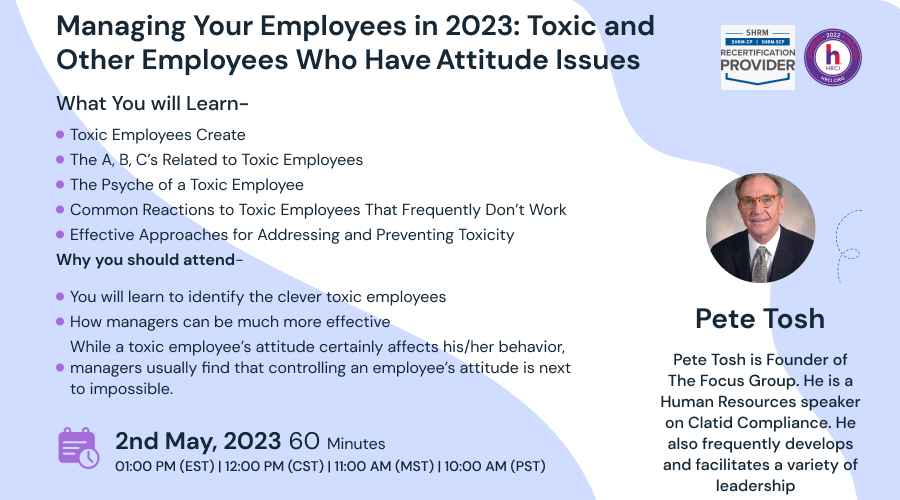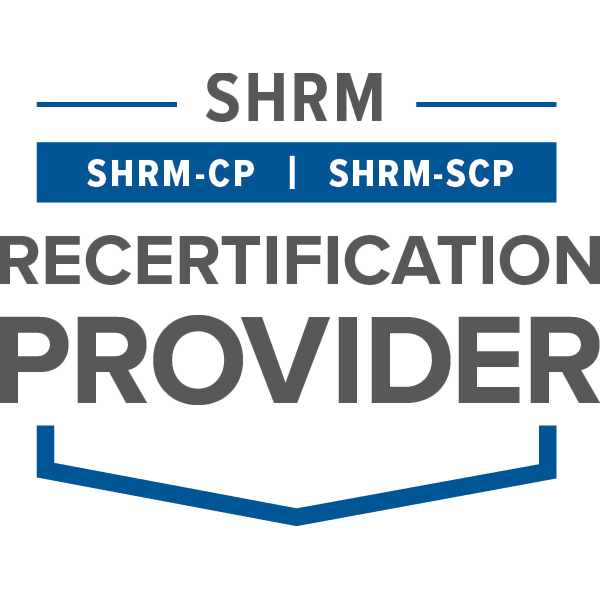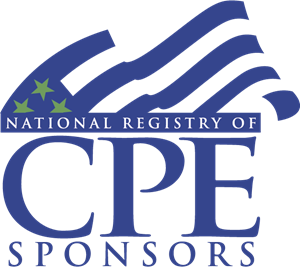- Topics
- Webinars
- Products & Services
- Customer Help
- Resources



Most organizations have employees who on occasion:
-Complain and gossip excessively
-Use inappropriate language
-Are mildly insubordinate
But Toxic Employees have interpersonal styles that demonstrate a pattern of counter-productive work behaviors. They cause significant overt, covert, people-related and financial damage with their visible behavior just being the tip of the iceberg. However, Emotionally Intelligent employees being aware of their feelings and those of others exhibit a pattern of appropriate self- management.
Join us this May to learn about the Human and Financial costs resulting from toxic Employees. You will learn the effective approaches for addressing and preventing toxicity in your workplace.
The toxic employee problem is surprisingly prevalent with research showing:
-95% of employees have and 64% are currently working with a toxic employee
-50% of employees have thought of quitting and 12% did because of a toxic employee
-25% of employees have reduced their work effort due to a toxic employee
-20% of employees feel they are a target weekly and 10% of employees see toxic behavior daily
You will learn to identify how the clever toxic employees:
-Utilize their technical expertise to intimidate and manipulate
-Know who to flatter and who they can abuse
-Turn their toxicity on and off depending on the impression they want to make
Unfortunately, organizations can work against themselves and even promote toxicity by:
-Restructuring his/her job to accommodate a toxic employee
-Tolerating toxic employees who have valued expertise
-Not assertively seeking employee feedback as to whether there is toxic behavior in the workplace
-Not communicating to all employees the specific interpersonal behaviors that will not be tolerated – with the associated consequences
-Managers sometimes attempt to fix this type of problem by addressing a toxic employee's attitude
While a toxic employee's attitude certainly affects his/her behavior, managers usually find that controlling an employee's attitude is next to impossible.
Managers can be much more effective by:
-Discussing the specific behaviors that are negatively impacting other employees and/or the organization
-Using positive and negative consequences to influence that behavior
I. Toxic Employees Create:
-Chaos and unnecessary complexity
-Overt damage
-Covert damage
-Strife, stress and emotional damage
-Productivity, quality and financial losses
II. The A, B, C’s Related to Toxic Employees
-Employee attitudes
-Employee behaviors
-Consequences that managers can exert
III. The Psyche of a Toxic Employee
-Frequently seen toxic behaviors
-Utilize ‘star status’ and technical expertise to intimidate and manipulate
-Chameleon who knows who to flatter and who he/she can abuse
-Turn their toxicity on and off depending on the impression they want to make
-Three common forms of toxic behavior
IV. Common Reactions to Toxic Employees That Frequently Don’t Work
-Restructuring his/her job to accommodate the toxic employee
-Tolerating toxic employees who bring rare expertise or experience
-Not assertively seeking feedback from employees as to whether there is toxic behavior in the workplace
-Not communicating to all employees, the specific behaviors that will not be tolerated with associated consequences
V. Effective Approaches for Addressing and Preventing Toxicity
Organization-wide strategies:
-Making positive interpersonal behavior an organizational value
-Evaluating interpersonal behavior as a part of the performance appraisal system
-Training leaders in how to address toxic behavior
-Using behavioral-based interview questions to screen toxic applicants
-Exit interviewing to identify any toxic behavior in the workplace
Departmental and team strategies:
-Defining appropriate interpersonal interactions with behavior-specific descriptions and standards
-Using team discussions and role plays to clarify the application of the behavioral descriptions and standards
-Utilizing a 360-degree feedback process to assess the work environment
One-on-one strategies:
-Stating explicitly that the behavior is not acceptable and why
-Describing both the unacceptable and acceptable behavior
-Asking the employee to commit to and describe how he/she will change his/her behavior
-Frequent, targeted counseling feedback
-Executive coaches
-Progressive discipline
-Termination
But even terminations are not a cure-all because the:
-Toxic-enabling people and organizational culture tendencies may remain
-Employees may still be resentful of the way they were treated by the employee and the time it took the organization to react
-Expertise and experience of the toxic employee are lost
-Managers
-HR professionals
-Leadership professionals
-Anyone with managerial or leadership responsibility
Pete Tosh is the Founder of The Focus Group, a management consulting and training firm that assists organizations in sustaining profitable growth through implementing strategic HR initiatives, maximizing leadership effectiveness, and strategic planning. He collaborates with Clatid Compliance to provide practical training and guidelines on Human Resources, leadership, and growth in business.
Pete has worked closely with the leadership teams of organizations such as Exxon, Brinks, EMC, State Farm, Marriott, N.C.I. YKK and Freddie Mac. He holds a B.A. degree in Psychology from Emory and Henry College and Master's degrees in both Business Administration and Industrial Psychology from Virginia Commonwealth University. He is also co-author of Leading Your Organization to the Next Level: the Core Disciplines of Sustained Profitable Growth. His firm has provided consulting and training services to manufacturing and service organizations across the U.S., Canada, Europe, and the Middle East.
SHRM-
Clatid is recognized by SHRM to offer Professional Development Credits (PDCs) for the SHRM-CPSM or SHRM-SCPSM.
This program is valid for 1.5 PDCs for the SHRM-CPSM or SHRM-SCPSM. For more information about certification or recertification, please visit - portal.shrm.org.
HRCI -
This webinar has been approved for 1.5 HR (General) re-certification credit hours toward California, GPHR, HRBP, HRMP, PHR, and SPHR recertification through the HR Certification Institute.
The use of this seal is not an endorsement by the HR Certification Institute of the quality of the activity. It means that this activity has met the HR Certification Institute’s criteria to be pre-approved for re-certification credit.
Sign up now on clatid.io. Visit clatid.io/webinar to discover a wide range of webinars from industry specialists. Tick on either ‘live webinar’ or ‘on-demand’, and simply click on ‘buy now’ to get enrolled.
You can refer Clatid to anyone in your social circle. Explore your industry with your colleagues by getting them signed up on clatid.io today!
Go for the topic of your keen interest on clatid.io. Tick on ‘live webinar’ and get enrolled! Easy registration, transparent transaction.
You can request for an on-demand webinar that records the live webinar for you. After the webinar ends, you will have full access to the webinar’s recording. You can also explore Clatid offline to order your webinar DVDs, flash drives and transcripts.
If you can’t attend the live webinar, simply go for the ‘on-demand webinar’ for the same price! Now, the live webinar recording will be saved in a cloud storage for you to access anytime from anywhere.
Clatid offers both hard and soft copies of the webinars. It contains all the highlights as well as comprehensive descriptions of the webinar, so you never miss out a single detail.
After attending the live webinar, your certificate will be emailed to you. You can download it and add more charm to your professional score.
At the end of each webinar, you have the opportunity to interact with your industry experts, where you will get answers to all your queries.
Can’t attend the live webinar? Clatid has got you covered! You can always switch to the on-demand webinar from your portal. You can also get your hands on the webinar’s DVD/flash drive and transcript. So order them now!
Clatid brings a variety of options for offline learning. Order your DVDs, flash drives or transcripts now to have a lifetime access to Clatid webinars. You can also go for on-demand recordings. Download and watch it anytime from anywhere in the world!


